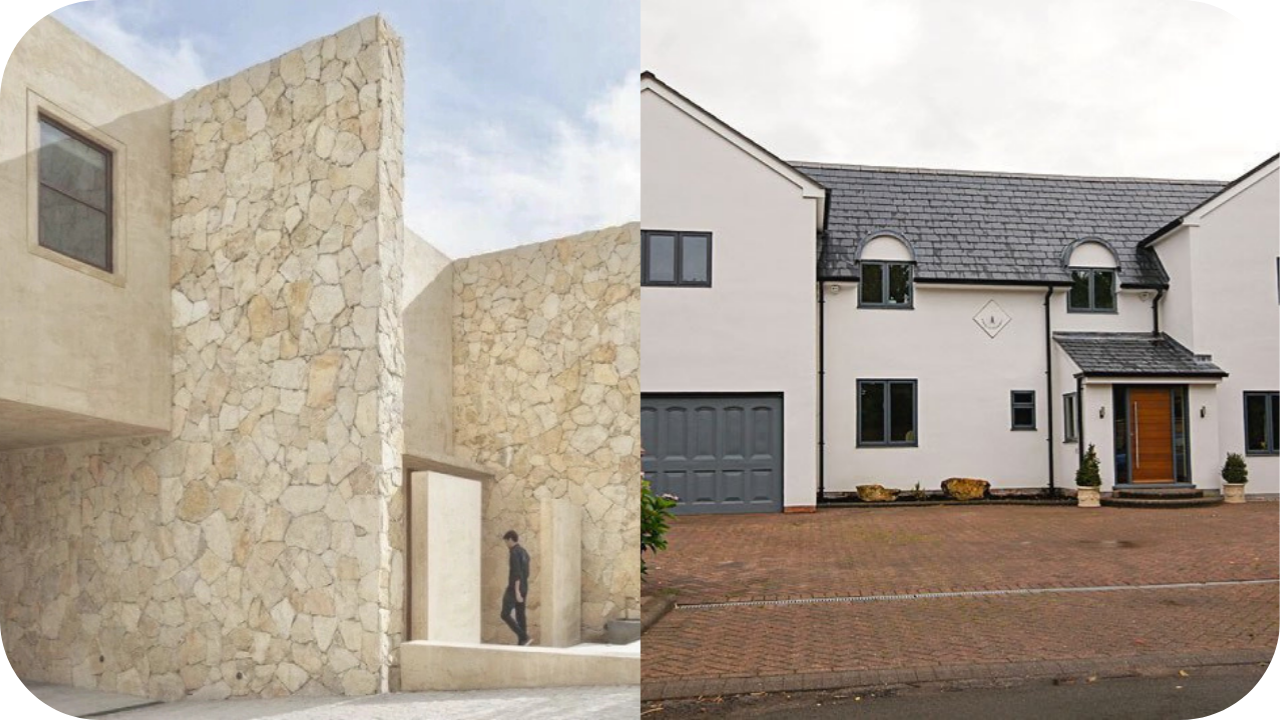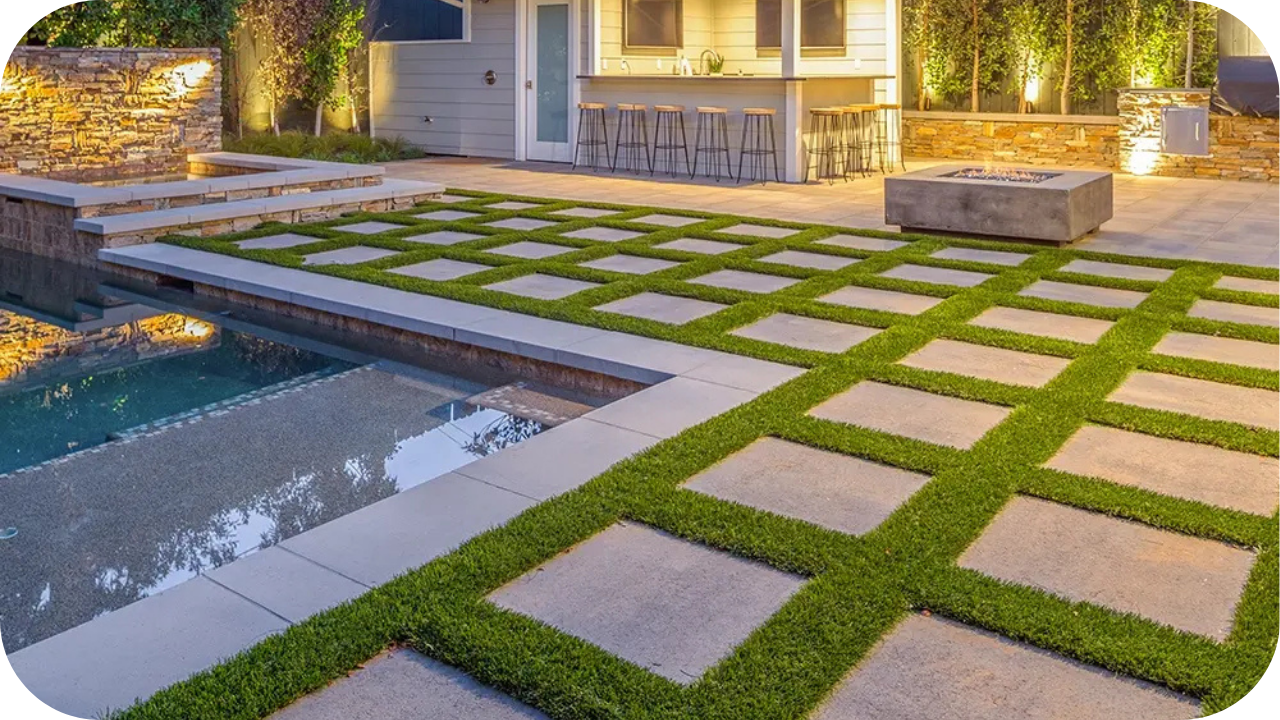
When it comes to enhancing your home’s exterior, the choice between cladding and render can have a significant impact. Both options provide a range of aesthetic and functional benefits, but which one is right for your home? The decision often comes down to style preferences, performance, and long-term maintenance.
At Splendour in Stone, we help homeowners and builders make informed decisions about their exterior finishes. In this guide, we’ll dig out the key differences between cladding and render, helping you choose the best option to suit your home’s design and needs.
What is Cladding?
Cladding is a protective outer layer that covers the structural frame of a building, providing both an aesthetic finish and additional protection from the elements.
Cladding can be applied to any surface, including walls, roofs, and even foundations, and it comes in a wide variety of materials—from natural stone to timber, metal, and composite panels.
Advantages of Cladding

Looking for a durable, stylish, and low-maintenance solution for your home’s exterior? Cladding offers all of this and more. Here’s why it’s a top choice for homeowners and designers alike:
- Durability: Cladding materials like stone, metal, and timber are incredibly resilient, providing long-lasting protection against harsh weather conditions. They withstand extreme temperatures, rain, UV rays, and physical wear, ensuring your home exterior remains intact and attractive for many years to come.
- Aesthetic Appeal: With a wide range of materials available, cladding offers diverse design possibilities. From sleek, contemporary metal panels to rustic timber and natural stone, you can achieve a variety of finishes that complement your home’s architectural style. Whether you’re after a polished, modern look or a more textured, traditional design, cladding can make it happen.
- Low Maintenance: Depending on the material, cladding requires minimal upkeep. Stone and metal, for example, only need occasional cleaning to maintain their appearance. Timber may require sealing every few years, but it’s still relatively low-maintenance compared to other exterior finishes like render, which may need to be repainted or resealed more often.
- Thermal Insulation: Many cladding materials, especially composite panels and timber, can offer improved insulation. By adding an extra layer of protection, cladding helps maintain your home’s internal temperature, reducing energy costs by improving energy efficiency. This is particularly beneficial in homes where climate control is essential.
- Protection Against the Elements: In addition to adding style, cladding acts as a protective barrier against the elements. It can help shield your home from moisture, wind, and even noise, providing comfort and reducing the risk of weather-related damage.
- Increased Property Value: Quality cladding can increase the value of your home by enhancing its curb appeal. Homes with modern, well-maintained exteriors tend to attract higher resale prices, making cladding a smart investment for the long term.
What is Render?

Render is a type of wall coating applied to exterior surfaces, typically made from sand, cement, lime, and sometimes acrylic or silicone additives for added flexibility.
Unlike cladding, which involves applying solid materials in panels, render is a thin, smooth coat applied directly to the wall’s surface. The finish can be textured, smooth, or coloured depending on the desired look.
Advantages of Render
Render offers a smooth and versatile finish, but its true value goes beyond just appearance. When you’re looking for a high-performance and cost-effective exterior solution, render ticks all the boxes. Here are some additional reasons why it’s a popular choice for homeowners:
- Versatility: Render can be applied to almost any surface, including brick, concrete, and blockwork, providing greater flexibility for customising finishes. Whether you want a smooth, textured, or coloured finish, render can be tailored to fit the exact style of your home. It works well on both modern and traditional designs, allowing for creative, personal touches.
- Seamless Appearance: One of the key benefits of render is its ability to create a seamless, continuous finish. With no visible joints or gaps, render gives your home a clean and polished look, making it ideal for minimalist or modern architecture. This feature is particularly advantageous for sleek, contemporary designs where sharp lines and smooth surfaces are essential.
- Cost-Effective: Render is generally more affordable compared to cladding materials, both in terms of material and installation costs. This makes it a budget-friendly option for homeowners looking to refresh their exterior without breaking the bank. When you consider the longevity and low maintenance of render, it offers exceptional value over time.
- Quick Installation: Render can be applied relatively quickly, especially in comparison to some cladding systems that require detailed work and precise installation. This makes render an excellent choice for projects with tight timelines, whether you’re building a new home, doing a renovation, or just updating your property’s exterior.
- Weather Resistance: Another major advantage of render is its ability to resist weathering. Once properly applied and sealed, render provides a strong barrier against rain, wind, and UV exposure. It also helps prevent damage from moisture by acting as a protective coat, which is especially important for homes in humid or coastal areas.
- Enhanced Insulation: Render can provide additional thermal insulation to your home’s exterior, improving its energy efficiency. When combined with an insulating backing board or external wall insulation, render can help regulate indoor temperatures, keeping your home cooler in summer and warmer in winter.
Key Differences Between Cladding and Render

When deciding between cladding and render, there are several important factors to consider, from aesthetic impact to durability, maintenance, and insulation properties.
1. Aesthetic Impact
Cladding offers a more textured, layered look due to the use of natural materials, creating visual depth. It’s ideal for homes with traditional, rustic, or industrial designs.
Render, on the other hand, offers a smooth, clean finish that is typically associated with modern or minimalist homes. It’s better suited to homeowners looking for sleek, contemporary finishes without visible seams.
2. Durability
Cladding, especially when made from durable materials like stone, metal, or composite, offers superior longevity compared to render.
While render is a robust finish, it is more prone to cracking over time, especially in regions with extreme temperature fluctuations. Cladding generally provides more protection against wear, weathering, and physical damage.
3. Maintenance
Cladding is generally easier to maintain, particularly when using materials like stone, which only requires occasional cleaning.
Render, on the other hand, can require more upkeep, as cracks and chips are common and must be repaired quickly to prevent water damage.
In addition, render surfaces may need to be repainted or resealed after several years, particularly in harsh weather conditions.
4. Insulation and Energy Efficiency
Both cladding and render can improve insulation, but to varying degrees. Some cladding materials, like composite panels, provide excellent thermal insulation.
Render can also offer insulating properties, especially when combined with additional layers such as external wall insulation systems. However, cladding generally provides a better layer of protection against temperature fluctuations and heat loss.
5. Cost Considerations
In terms of initial cost, render is generally more affordable, both in terms of material and installation.
Cladding, while often more expensive, provides superior durability and can add significant value to your home, especially when using high-end materials like stone or quality timber.
Which Option Works Best for Your Home?

Choosing between cladding and render depends on several key factors—the style of your home, your climate, and how much maintenance you’re willing to commit to. Consider these points when making your decision:
- Traditional or Rustic Home: If your home is more traditional, rustic, or industrial, cladding (especially stone or timber) will blend beautifully with your design. It adds texture, character, and protection.
- Modern or Minimalist Design: For a sleek, contemporary aesthetic, render is the perfect choice. It gives your home a smooth, uninterrupted finish that aligns with modern design trends.
- Climate Considerations: If you live in a region with harsh weather conditions or high humidity, cladding may offer better protection against the elements. In contrast, render may perform better in dry climates but requires regular maintenance in wetter, colder regions.
- Low Maintenance: If you’re after a low-maintenance solution, cladding—particularly stone—requires minimal upkeep compared to render, which may require more frequent repairs and painting.
Conclusion
The decision between cladding and render comes down to the specific needs of your home. Cladding offers superior durability, aesthetic depth, and long-term performance, making it an ideal option for those looking for lasting beauty and low maintenance. Render, while cost-effective and quick to install, offers a sleek, smooth finish but may require more upkeep in the long run.
Need help choosing the right finish for your home’s exterior? Contact the team at Splendour in Stone for expert advice, material samples, and tailored recommendations to bring your vision to life.
More To Explore

Paving Stones in Craigieburn for Patios and Walkways
Creating the perfect outdoor space starts with the right foundation. In Craigieburn, homeowners are turning to natural stone paving to enhance their patios and walkways

Cladding or Render? Which Suits Your Home Exterior?
When it comes to enhancing your home’s exterior, the choice between cladding and render can have a significant impact. Both options provide a range of


